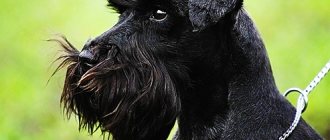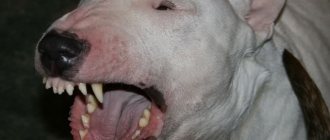As different dog breeds become more common, genetic health problems in animals are becoming more common. In fact, according to research into hereditary diseases, some breeds are so riddled with health problems that they require new DNA as a species ill-adapted to their environment.
Taking home dogs from shelters instead of buying them from breeders is very beneficial for a number of reasons, including reducing the risk of inherited health problems. A dog's health largely depends on individual circumstances. Below are the ten most popular dog breeds that are susceptible to serious diseases at the genetic level.
Basset Hound
The most significant health problems: platelet dysfunction, seborrhea.
Basset hounds originated in Belgium and France ("basset" means "low" in French) as hunting companions. Their excellent sense of smell is second only to the Blood Hound. But their sagging skin can cause health problems.
The most critical conditions associated with the breed are platelet dysfunction (blood clotting problems) and seborrhea (chronic skin problems). Other disorders directly associated with this breed are ectropion and entropion (abnormal eyelid rotation), exposure keratopathy syndrome (increased tear evaporation and corneal exposure), and intervertebral disc disease.
French bulldogs
Like Pugs, French Bulldogs have breathing problems. Therefore, they find it difficult to tolerate physical activity. The folds on their body cause them to overheat.
The height of the withers, the position of the pelvis and paws lead to the development of diseases of the spine. Most of them are associated with wear and tear of the intervertebral discs. The weak point of bulldogs is their eyes - many representatives of the breed suffer from cataracts.
An improper diet can cause gastrointestinal diseases. In addition, French bulldogs are characterized by ailments of the reproductive system. Thus, quite often males are not capable of bearing offspring, and females cannot fully bear and give birth.
If you know what diseases your pet is prone to, you can take care of their prevention.
Bernese Mountain Dog
The most significant genetic disorders: meningitis, elbow dysplasia, hip dysplasia, histiocytosis.
Cabbage cutlets: an easy recipe with simple ingredients
I wash off my makeup with Chlorhexidine: bloggers appreciated Asmus’ New Year’s gift
Start in 2021. Electronic passports will be introduced in Moscow
The good-natured Bernese Mountain Dog began its history as a farm dog in Bern, Switzerland. The dog had many tasks: herd livestock, drag loads, guard farms and serve as a companion on the road. Unfortunately, these dogs live between 7 and 10 years and may encounter some problems throughout their lives.
Berne is susceptible to a certain type of meningitis (inflammation of the brain and spinal cord), which is thought to be hereditary. They are also prone to histiocytosis, a collection of cells (histiocytes) that can be cancerous. In addition, subaortic stenosis (heart disease) and entropy (irritation of the eyelids) are common in the breed.
Boxer
The most significant genetic disorders: arrhythmogenic right ventricular cardiomyopathy, corneal dystrophy, degenerative myelopathy, dilated cardiomyopathy, subaortic stenosis.
Boxers are an ancient dog breed that has been around since 2500 BC. e. As these dogs evolved, they worked as hunters, herders, home protectors, service animals, and many other roles. Even though the dog looks very strong on the outside, he may have some health problems.
Quickly improve your mood and more: experts talk about the benefits of a diary
Cake “Inspiration”: a dessert recipe that will never get boring
The study of quantum physics and microbiology is reflected in the artist’s works (photo)
Boxers are prone to arrhythmogenic right ventricular cardiomyopathy (also known as boxer cardiomyopathy), a heart condition that causes an erratic heartbeat. Some may also develop dilated cardiomyopathy or subaortic stenosis, which are heart-related conditions. In addition, dogs are predisposed to degenerative myelopathy (a progressive disease of the spinal cord) and vision problems.
Cavalier King Charles Spaniel
The most significant genetic disorders are mitral valve dysplasia, cyaripus anomaly and syringomyelia.
The Cavalier King Charles Spaniel's sweet face reflects his good-natured nature well. Small spaniels were favorites of European nobility, although the Cavaliers we see today have domed skulls and flatter faces than in King Charles's time. This is the source of some of the health problems they inherit.
About 95 percent of Cavaliers inherit the condition syringomyelia. The back of the skull is too small for the parts of the brain it contains (cerebellum and brain stem), the brains press on the foramen magnum (the opening from the skull to the spinal canal), causing varying degrees of obstruction and therefore abnormal movement and pressure of the cerebrospinal fluid. Pain is the most common symptom, although many dogs experience no signs of pain at all.
For Isaac Newton's birthday: how the son of an illiterate farmer became a great physicist
Layered salad “Vitaminka” is my favorite: both tasty and healthy. Especially in winter
What was the fate of Alena, whom Nikolai Rybnikov adopted in 1957
Cavaliers are also susceptible to heart and eye problems, as well as brachycephalic syndrome (airway obstruction due to their short heads).
Dachshund
The most significant genetic disorders: acanthosis nigricans, intervertebral disc diseases.
Friendly, alert and small, dachshunds are famous for their elongated bodies. Because they are very short, they make excellent hunting partners for badgers in their underground burrows. But their breeding for sale has led to major health problems.
Like Basset Hounds, Dachshunds are prone to intervertebral disc disease due to their short legs and long back. Herniated discs in these dogs occur at a relatively young age (3 to 6 years), usually occur in several places in the back and cause severe pain.
Dachshunds are almost the only dogs that have inherited a primary form of acanthosis, a skin condition that causes hyperpigmentation, thickened skin, hair loss, itching and infection.
Corgi
This breed is predisposed to many diseases, especially obesity. It’s not surprising, because corgis are big food lovers. If you decide to get a dog of this breed, you should under no circumstances give up slack and treat your pet at his first request.
Corgis are also prone to food allergies due to poor diet, which are manifested by itchy skin and diarrhea. Another common health problem is skin diseases. Most often it is gray eczema.
Possible:
- epilepsy;
- cervical disc diseases;
- cystonuria;
- dental diseases.
English bulldog
The most significant genetic disorders: brachycephalic syndrome, hip dysplasia, keratoconjunctivitis sicca (dry eyes), pulmonary stenosis, ventricular septal defect.
How God helped before Christmas: this story was told by Bishop Panteleimon
Juicy cupcake with persimmons and nuts: my favorite treat for tea
George Clooney spoke about the state of the film industry now
Bulldogs are very recognizable by their wrinkled heads and sunken noses. And these features, which have only multiplied over the decades, now cause them several serious health problems.
Like other short dogs, all varieties of bulldogs are prone to brachycephalic syndrome. They may also experience breathing problems due to a hypoplastic trachea or abnormal cartilage growth that narrows the airway. In addition, they tend to inherit heart disease, and many of the dogs suffer from skin diseases due to skin folds. These dogs often require medical intervention when giving birth because their body cannot give birth on its own without risks to the animal itself.
Jack Russell Terriers
Representatives of this breed may develop a hereditary disease - hip dysplasia, characterized by flattening of the socket of the joint. Because of this, the head of the femur falls out of the joint during severe physical exertion.
Individuals that are light in color often suffer from congenital deafness. The disease can be detected from birth. Unfortunately, it cannot be treated.
Aseptic necrosis of the femoral head is another unpleasant disease characteristic of this breed. As a result, the head of the femur dies. To detect it, it is necessary to conduct an x-ray examination. Treatment involves only surgery.
Jack Russell Terriers are also characterized by:
- eye development abnormalities;
- diabetes;
- arthritis;
- allergies.
German Shepherd
The most significant genetic disorders: degenerative myelopathy, exocrine pancreatic insufficiency, hemophilia, hip dysplasia, renal cystadenocarcinoma and nodular dermatofibrosis, pannus/chronic superficial keratitis, panosteitis, perianal fistula.
The loyal and courageous German Shepherd has been a very reliable dog for many generations. Shepherds are descended from German herding dogs and were used on farms for a long time before becoming popular as police dogs and other working dogs. Although they are very strong, fast and agile, their health is also subject to careful monitoring, due to their tendency to certain diseases.
A disorder that affects many German Shepherds is degenerative myelopathy, a progressive disease of the spinal cord that eventually causes paralysis. Additionally, hip dysplasia, which also affects mobility, is a common condition in this breed.
Pugs
These dogs are brachycephalic breeds. Their characteristic feature is the presence of a flattened muzzle, which causes tenderness and a smile in many. In fact, this is not so funny and amusing: due to difficulty breathing, the dog’s body does not receive enough oxygen, which leads to rapid fatigue and exhaustion.
In addition, pugs have folds on their skin, which also affect their health. They can cause the animal to overheat and are a favorable environment for infectious skin lesions.
Teeth are another weak point of this breed. Don't forget that these dogs can be obese.
Golden retriever
The most significant genetic disorders: elbow dysplasia, hip dysplasia, retinal dysplasia, subaortic stenosis.
Golden Retrievers are popular for a variety of reasons. They are friendly, smart and dedicated to their work. Golden Retrievers were developed in the 1800s in the Scottish Highlands. Since then, every dog has found its role in every corner of the world. But unfortunately, many face some serious problems.
Retrievers are vulnerable to elbow and hip dysplasia, as well as eye problems that can cause irritation and vision loss. These dogs are also susceptible to cancer, although the extent to which genetics plays a role in this has not yet been determined.
German dog
The most significant genetic disorders: dilated cardiomyopathy, instability of the cervical vertebrae, dilatation (volvulus) of the stomach, hip dysplasia
With a weight of up to 70 kilograms and a height of up to 80 centimeters, these dogs are truly friendly, patient and gentle giants.
Their impressive height may also be a source of certain inherited disorders. Like other breeds with deep, narrow chests, Danes are prone to stomach distension, also called bloat. This is a life-threatening condition in which the stomach fills with air and twists, interfering with blood flow. Danes can also develop cervical vertebral instability (compression of the spinal cord in the cervical region due to abnormal structure).
Reasons for dogs' predisposition to common diseases
A predisposition to the disease in a dog of a certain breed may be detected at a very early age, or may not appear until a very old age. The course of pregnancy in the mother, heredity, conditions of keeping and feeding the puppy, and then the adult dog - these are the main reasons, the combination of which determines whether a particular disease will manifest itself in the dog or whether it will live out its canine life in good health.
Hereditary predisposition to various diseases varies among dogs of the same breed. For example, dogs whose pedigrees come from the same ancestors may not suffer from diseases typical of a given breed in almost any generation, while a dog with other ancestors may have a pronounced predisposition to the disease.
That is why every owner should know the most typical diseases to which dogs of a particular breed are prone, so that when purchasing a puppy, they can try to recognize the early signs of the disease, and when raising a dog, they can take appropriate measures to preserve the health of their pet.
Features of diseases of large breeds of dogs
Owners of dogs belonging to large, massive breeds (St. Bernards, Newfoundlands, shepherds of all types, Great Danes, Rottweilers, Mastinos, Bull Terriers, Mastiffs) should pay special attention to the formation of the dog’s bone skeleton. The rapid growth of a dog with improper nutrition and poor care, intensive training at an early age (up to 14 months) causes deformation of the hip joints.
This is due to the fact that a significant portion of a dog's mass is located on the back of its body. The manifestation of the disease is observed only at the age of about two years and older, when neither medications nor surgical treatment can no longer ensure the dog’s recovery, but can only alleviate the course of the disease.
The disease manifests itself in the animal’s unstable gait, impaired motor function of the limbs, and is accompanied by painful movements. An accurate diagnosis can be made using fluoroscopic examination.
If treatment is not started on time, the development of the disease leads to displacement of the femur, atrophy of the thigh muscles, and paralysis of one or both limbs.
Features of diseases of dog breeds with a weighted front part of the body
Dogs with a weighted front part of the body (bassets, dachshunds, Pekingese, bulldogs) suffer from deformation of the elbow joints if raised and maintained improperly. The manifestation of the disease is facilitated by excessive physical activity, frequent descents and ascents of stairs, and jumping from heights. The disease manifests itself in lameness, deformation of the bones and softness of the metacarpus, it leads to gradual numbness of the limb and ultimately to complete muscle atrophy.
Features of diseases of dog breeds with an elongated body
Dogs with an elongated body and short legs are prone to acquiring paralysis of the rear part of the body. Dachshunds and basset hounds and short-legged terriers are especially susceptible to this disease. The occurrence of the disease is facilitated by the dog being overweight, intense running, jumping and walking on stairs.
At first, the dog suffers from incoordination of movements, then pain and convulsions appear, and finally paralysis.
Features of diseases of other dog breeds
In small breed dogs, as well as Doberman Pinschers, Chow Chows and some others, congenital instability of the cervical vertebrae is observed, causing deformation of the cervical spine. This leads to increased pressure on the spinal cord. The disease manifests itself in the animal's staggering gait, and if left untreated, leads to paralysis of the hind legs or all four legs.
Yorkshire Terrier
The most significant genetic disorders: patellar luxation, portosystemic shunt, tracheal collapse, retinal dysplasia.
Yorkshire terriers are known as adorable little dogs, even though their purpose was not the same. Real Yorkies worked as rodent exterminators in textile and coal factories.
Yorkies commonly have eye problems, including entropy and retinal dysplasia, which can lead to vision loss. They are also susceptible to patellar luxation, a condition in which the kneecap slips out of place. Additionally, some may inherit a portosystemic shunt, which causes abnormal blood flow through the liver.
Found a violation? Report content











